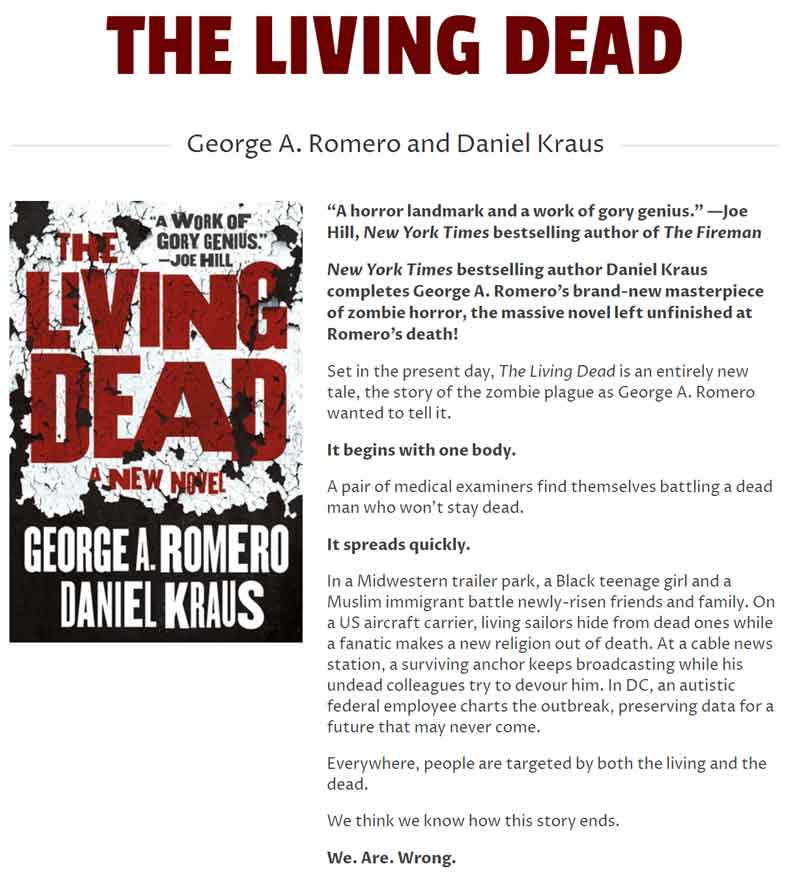 By GEORGE A. ROMERO, DANIEL KRAUS (Tor; 2020)
By GEORGE A. ROMERO, DANIEL KRAUS (Tor; 2020)
This zombie epic was extrapolated from an unfinished George Romero manuscript by novelist Daniel Kraus (of the SHAPE OF WATER novelization and numerous other books). Clocking in at nearly 700 densely packed pages, THE LIVING DEAD seeks to be nothing less than the zombie novel to end all zombie novels, with a scope that Romero was never able to achieve in his low budget films. Such ambition is laudable, but also foolhardy, especially in a subgenre that has, frankly, been done to death. There’s a great deal to recommend here, but I’m afraid this is not the zombie novel to end them all.
A lengthy afterword by Kraus fills us in on the travails he faced in putting together this novel. Romero apparently completed less than half of it before he died (despite a promise he made to keep it going “until I’m diagnosed as terminal, at which point I’ll, real quick, whip up an ending”), but left behind detailed notes Kraus utilized in crafting the narrative, as well as 100 pages of another unfinished novel entitled THE DEATH OF DEATH, which was incorporated into the whole, and a short story whose final three words conclude THE LIVING DEAD.
With so many disparate sources mixed in, it’s no surprise that THE LIVING DEAD is a choppy and discordant reading experience. It suffers from an excess of principals alive, dead and undead, with new characters still being introduced in the final hundred pages, and it certainly doesn’t help matters that George Romero and Daniel Kraus tend toward lugubrious prose like “We want to whisk her away from that hothouse, address her injured flesh, show her our own. Perhaps by doing do so, we can still be saved”(?).
Again, though, the epic thrust of the novel is impressive, with Kraus effectively blending his own authorial voice with that of Mr. Romero. The novel begins with a corpse, identified as John Doe, inexplicably springing back to life (making this the second time Romero has rebooted his living dead concept), much to the consternation of Luis Acocella, an assistant medical examiner—and the closest thing this sprawling tale has to a protagonist. From there we’re thrust forward over the following eleven years, as the living dead, who as we know eat human flesh and can only be felled by a bullet in the head, quickly overtake the world and society collapses.
Among the settings are a naval ship, upon which the resident priest connects the particulars of his religion a little closely with the bloody mayhem engendered by the deaders; a cable news network, where we’re introduced to an anchor known as the Face, so named because of his good looks (which aren’t destined to last much longer); and a safe haven created by a gaggle of non-zombified folk that, needless to add, is destined for roughly the same unpleasant fate as most of the humans depicted in this book.
You can be sure that Romero, who was deeply concerned with the thematic content of his films, is careful to highlight his themes (as is Kraus), of which there are a lot. Environmental depletion, income inequality, indentured servitude, school shootings, religious persecution, animal cruelty, elder abuse and America’s declining role in the world order are all picked over in an account that also features undead animals, old man/lady zombies (called “softies”) and an immersive depiction of exactly what occurs in one’s consciousness between the loss of life and the onset of zombiehood.
The problem is that all this has been done before, and (for the most part) better. See Romero’s six films on the subject (NIGHT OF THE LIVING DEAD, DAWN OF THE DEAD, DAY OF THE DEAD, LAND OF THE DEAD, DIARY OF THE DEAD and SURVIVAL OF THE DEAD), as well as WORLD WAR Z (novel and film), THE WALKING DEAD (graphic novel series, TV show and prose fiction cycle) and innumerable other examples of zombie-themed media. Twenty years ago THE LIVING DEAD may indeed have been the genre landmark it so desperately wants to be, but right now it comes off as a well-intentioned but late-to-the-party addendum.

